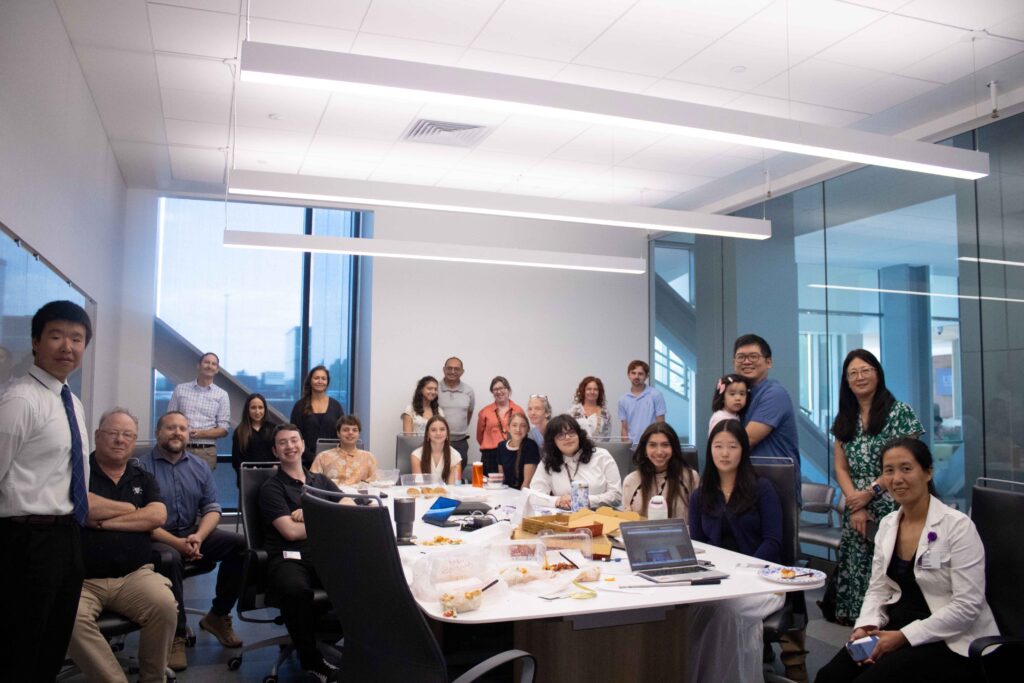Sight + Sound, Fall 2025
By participating in the Vision Institute’s Vision Site at the Hillman Summer Academy, the Department of Ophthalmology increases its visibility and leadership in Vision Science, enriches its educational mission, supports broader goals, amplifies its community outreach, and cultivates future talent. The Vision Site is one of nine sites, all of which “strive to provide cutting edge research and career preparatory experience to a diverse group of highly motivated high school students who are pursuing higher education and careers in STEM fields, especially research and medicine,” said Yuanyuan Chen, PhD, Assistant Professor of Ophthalmology and the Vision Site head.
The Department has been participating in this program for five years, hosting 6-9 students each year. Over 55% of the students are from underrepresented backgrounds, supported with lunch cards, bus passes, and a $2400 fellowship for their commitment. Funding is supported by the Eye & Ear Foundation and Hillman Foundation attributed to Dr. José-Alain Sahel, Chair of the Department.
Lasting about seven weeks, the curriculum is well-developed and includes a full week wetlab bootcamp led by Dr. Chen and Kate Davoli, MDiv-HTL (ASCP)cm, Laboratory Manager for Tissue Culture and Histology Research cores at the University of Pittsburgh School of Medicine, teaching basic skills on bench. This is followed by full-time lab research experiences with mentors in each lab but mainly from the Department of Ophthalmology. Final day presentations, awards, and a closing ceremony round out the program.
“This year, the students attended our Vision Research Day and Department retreat,” Dr. Chen said. “Their attendance to our Department activities helped them merge into the daily life of research professions.”
Jackie Tang, a high school senior, wanted to participate in the program so she could gain real research experience, which is rarely available for high school students. With her mentor, Dr. Kun-Che Chang, she learned the basics of lab etiquette and worked on her ability to carry out experiments. Since she was not very familiar with the subject of the research she worked on, she said it was “super helpful” to have her mentor available to explain anything she found confusing.
Jackie’s research focused on the effects of the growth factor IGF-1 on retinal ganglion cell axon outgrowth. She was also able to help some of the other lab members with their experiments and observe a lot of interesting and more complicated experiments.
The program further convinced Jackie to pursue a career in the sciences and helped her realize she really enjoys research – something she was not sure of before. She plans to attend university to study biology and then pursue a career in medicine.
“I think this program is truly amazing and provided me with an unforgettable experience,” Jackie said. “One thing I think people (mainly students) should know about the program is that it’s actually not as stressful as it may seem and is really fun. When I was applying, I was a little bit scared that it would be too much work, but everyone is very kind and understanding and want to see the students succeed.”
Another participant, Aubrey Sudor, is a high school junior who wanted to be exposed to what it would feel like to have a job, especially in research. She worked with Tobii Pro 3 glasses, which tracked her real-world eye movements. Now she is thinking of becoming a neurologist, “since my research was more in trying to understand why our brains create those movements, and I liked that concept,” she said. The program is “worth the time,” she added. “At first, it seems like it will be very long and tiring. It ended up being the complete opposite! It was very fun and educational and every day I did something different.”
J. Patrick Mayo, PhD, Assistant Professor in the Departments of Ophthalmology and Bioengineering, was Aubrey’s mentor. He got involved with the program because he likes introducing young people to science. “I think the world of research is vastly broader and more interesting than they realize,” he said. “I also like to give people an opportunity that they might not otherwise have access to. And it’s fun to have a “young person” in the lab.”
Dr. Mayo spent a few hours each week introducing Aubrey to the project, explaining why it was important, and discussing their role in the research. This high-level discussion was always accompanied by more technical discussions of how to carry out the project, collect and analyze data, and how to properly document their scientific progress (and presentations). The data that Aubrey collected are being used to study the prevalence of different types of eye movements during natural visual behavior. “These measurements are critical for guiding basic research because they help point to the most relevant behaviors during everyday experiences,” Dr. Mayo explained. “These are most often the behaviors that patients also have difficulty with if and when visual deficits develop.”
Previous students have been admitted to CMU, UCLA, Brown, Pitt, Allegheny College, Boston University, and Brandeis University. Many have come back to the Department to continue research training after starting college.
